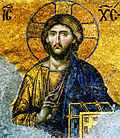Divine Liturgy of St. John Chrysostom
| Part of a series on |
| Eastern Christianity |
|---|
 |
|
Liturgy and worship |
|
The Divine Liturgy of Saint John Chrysostom is the most celebrated Divine Liturgy in the Byzantine Rite. It is named after the anaphora with the same name which is its core part and it is attributed to Saint John Chrysostom, Archbishop of Constantinople in the 5th century.
It reflects the work of the Cappadocian Fathers to both combat heresy and define Trinitarian theology for the Christian Church. The Liturgy of St. John Chrysostom was probably the divine liturgy used originally by the School of Antioch and was, therefore, most likely developed from West Syrian liturgical rites. In Constantinople, it was refined and beautified under John's guidance as Patriarch of Constantinople (398–404). Having become the liturgical form of the Church of Holy Wisdom, Hagia Sophia, it became over time the normative liturgical form in the churches within the Byzantine Empire. The two liturgical rites of St. John Chrysostom and St. Basil in the Eastern Church became the norm by the end of the reign of Justinian I.[1]
Musical settings
- Liturgy of St. John Chrysostom (Tchaikovsky), op. 41, a chorale composed by Pyotr Tchaikovsky in 1880.
- Liturgy of St. John Chrysostom (Rimsky-Korsakov), op. 22, a chorale composed by Nikolay Rimsky-Korsakov in 1883.
- Divine Liturgy of St. John Chrysostom (Mokranjac), a chorale composed by Stevan Mokranjac in 1895.
- Liturgy of St. John Chrysostom (Kastalsky), a chorale composed by Alexander Kastalsky in 1905.
- Liturgy of St. John Chrysostom (Rachmaninoff), op. 31, a chorale composed by Sergei Rachmaninoff in 1910.
- Liturgy of St. John Chrysostom (Leontovych), musical setting composed by Mykola Leontovych in 1919.
- Liturgy of St. John Chrysostom (Levine), a chorale composed by Alexander Levine in 2006
See also
- Anaphora (liturgy)
- Liturgy of St. Basil
- Liturgy of St. James
References
- ↑ "Chrysostom", Early liturgy, Liturgica.